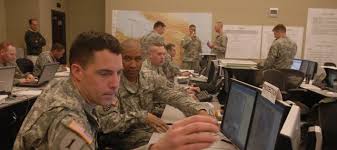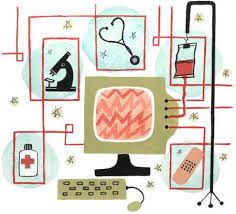
Currently I teach 5th grade math in a small (just over 500 students in K-6th grade) elementary school in Allen, Texas. Years ago, I taught math on a secondary level at a private school north of Houston. There are so many differences in education today as opposed to 15 years ago and in private schools as compared to public schools. Access to resources is one massive difference!
Fortunately, I am teaching in a district that is very proactive in their approach to technology in the classroom! My classroom is a technology-rich environment including flipping a couple of lessons per week. This gives students the opportunity to hear the instructional piece of the lesson at home via Edmodo.com and take notes in their journal. When we are together in the classroom we are able to apply those lessons with practical activities. The benefit for me as their teacher is that I have more usable face-to-face time with them to make sure they are understanding the concept correctly.
Students benefit from having the opportunities to learn about and from technology; teachers benefit from having so many tools for diverse learners with the technology options. Of course there are flip sides to any topic, but for me there are so many positives about having technoogy in the classroom that it more than outweighs any negatives that I've seen!
In reading the material from this week's unit, I see distinct bridges between the uses of technology in different settings to uses in education. Resourceful teachers find many opportunities to employ technology in the classroom since it is so beneficial to a classroom full of students with many different learning styles. We are able to offer students material in their learning style and give them opportunities to demonstrate their understanding of a concept in a way that makes sense to them. As explained in the text, this was much more difficult before classrooms were equipped with computers and when those computers did not have internet access.
 However, in a recent study, PBS found that while many teachers have computers in their classroom, a only small percentage feel that they have access to appropriate technology for their level of students or their curriculum area. Clearly this relates to the information that we read about in our text this week when the author explained that if we aren't using the technology dollars in an effective way, the money is essentially wasted. Unfortunately, PBS found that many teachers were simply using their classroom technology for glorified word processors rather than having technology that could enhance their students' learning. In my opinion, that is just simply unacceptable in today's classroom! The students of today are competing in a global marketplace for jobs and we need to equip them to be successful. Technology is a huge part of that equation.
However, in a recent study, PBS found that while many teachers have computers in their classroom, a only small percentage feel that they have access to appropriate technology for their level of students or their curriculum area. Clearly this relates to the information that we read about in our text this week when the author explained that if we aren't using the technology dollars in an effective way, the money is essentially wasted. Unfortunately, PBS found that many teachers were simply using their classroom technology for glorified word processors rather than having technology that could enhance their students' learning. In my opinion, that is just simply unacceptable in today's classroom! The students of today are competing in a global marketplace for jobs and we need to equip them to be successful. Technology is a huge part of that equation.
I found the use of technology for training in the military to be very interesting. I was raised as an Army brat and my brother and his wife are both currently involved in training areas in the Navy. My brother recently retired from his Naval position but went directly into the same position as a contractor. His wife writes and designs computer-based training modules for the Department of Defense. One difficult area of staffing the training department that I think the text book missed goes hand in hand with finding enough staff to create the training. That area is finding people with appropriate clearance to have access to top secret information in order to produce the training materials. This has essentially been a career for my brother and his wife because they both not only have the experience from going through the ranks of the Navy, but they also have the appropriate clearance level to make themselves about as close to indispensable as one can be in a military position.

Having technology based training for the military has made our military much more effective through the years. As the transitions have been made over the last couple of decades to computer based training, advances have been possible because training is consistent across the entire branch rather than a specific base having one trainer teach something different than another base. In education, we have made similar changes as TEA has been able to provide immediate access to essential standards and the changes that are made via their website rather than trying to disseminate that information to every school district and school across the state. This allows district to stay current in their curriculum and provides students with some confidence in what they've learned if they move from one Texas school district to another.

I have a very close friend who has recently accepted a position as the director of Memory Care Unit. He describes his unit as "old school" when it comes to technology. I asked him what that means and his response was that it means that there is none! I was shocked! No computer in a medical unit?! How in the world does it function without technology? He explained that right now all charts are done by hand. I would agree that is definitely old school.
They are going through the process of training all of their staff to move to a computer management system over the next year as the state has mandated that all medical facilities be computerized. His staff is feeling a lot of stress as they prepare for this change, but they are also having to address significant changes in the way they will operate and how they will handle integrating written records into the new system.
When I thought about his situation in comparison to my industry, a fellow teacher came to mind. She is old school in her style and has no intention of changing that. She is only a year away from retirement and feels like there is absolutely no good reason to make a change when what she has always done is still working. When her team or the administration wants to initiate a change that involves technology, she finds herself in a difficult and very stressful situation. Our campus administration has all but mandated the integration of technology and instead of embracing the benefits for the students and for herself, she has dug her heels in and refused.
As a beneficiary of an online education opportunity, I find so many positives about this type of program that I'm not sure where to begin. About 5 years ago, I found that in order to continue to do what I love, which is teach, I needed to go back to school to make myself more marketable. I was able to complete a second undergraduate degree, complete a full alternative teacher certification program, and now nearly complete my master's degree while never once setting foot on the campus. None of that would have been possible without the option of online learning. We needed my income, so a traditional classroom setting wouldn't work. I wasn't willing to go to night school and miss out on time with my family. Also, my husband's job requires a good bit of travel, so I needed the flexibility of doing the course work on my own schedule. For me, online learning has afforded me a path to reach my goals!

From this chart, you can see that faculty members also see the benefits of offering online classes! Yes, some only teach in an online setting because of the requirement, but many find here that the benefits far outweigh the stress of change. As I began down the path this year of offering online learning for my students, though on a much smaller scale, I see some of the same benefits found in this survey. As I mentioned above, having a way to reach many different learning styles in my student body is my top motivation for teaching some lessons online. The second motivating factor for me is freeing up time that I have with my students in my classroom. Rather than lecture while I have them, I can use that time to work with them on the concept in a variety of ways. It is a much better use of our time and a much more effective way to teach math!
